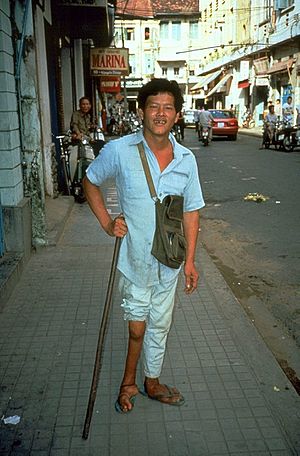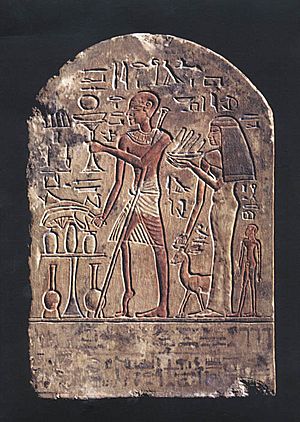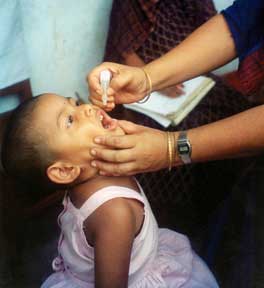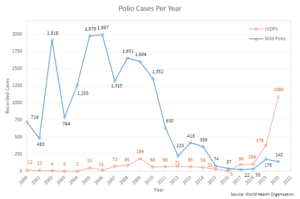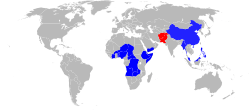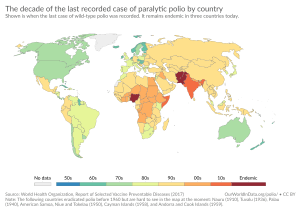Poliomyelitis facts for kids
Poliomyelitis, or polio, is a virus that causes a serious disease. It is spread from person to person.
Most of the time, polio has no symptoms unless the polio virus gets into the blood. It is uncommon for the virus to enter the brain or spinal cord. If this does happen, it can cause muscles to become paralyzed. Some people get better from the paralysis. Others will be disabled. Depending on which muscles have been affected, these people may need a mobility aid or a wheelchair; they may have difficulty using their hands; or they may even have trouble breathing.
About 15 out of every 10,000 adults who get polio die. (This means an adult has a 0.015% chance of dying from polio.)
Vaccination with polio vaccines could stop the disease all over the world. Organizations like the World Health Organization have been trying to vaccinate as many people as possible against polio. Vaccinations have eliminated polio from most countries in the world.
Worldwide, polio has become much less common in the past few decades. In 1988, there were about 350,000 cases of polio in the world. By 2007, the number of cases of polio in the world had decreased by over 99.9%, to just 1,652 cases.
The 32nd President of the United States, Franklin Delano Roosevelt, had polio. So far, he is the only President of the United States to have had this disease.
Contents
History
The effects of polio have been known since prehistory; Egyptian paintings and carvings depict otherwise healthy people with withered limbs, and young children walking with canes. The first clinical description was provided by the English physician Michael Underwood in 1789, where he refers to polio as "a debility of the lower extremities". The work of physicians Jakob Heine in 1840 and Karl Oskar Medin in 1890 led to it being known as Heine–Medin disease. The disease was later called infantile paralysis, based on its propensity to affect children.
Before the 20th century, polio infections were rarely seen in infants before six months of age, most cases occurring in children six months to four years of age. Poorer sanitation of the time resulted in constant exposure to the virus, which enhanced a natural immunity within the population. In developed countries during the late 19th and early 20th centuries, improvements were made in community sanitation, including better sewage disposal and clean water supplies. These changes drastically increased the proportion of children and adults at risk of paralytic polio infection, by reducing childhood exposure and immunity to the disease.
Small localized paralytic polio epidemics began to appear in Europe and the United States around 1900. Outbreaks reached pandemic proportions in Europe, North America, Australia, and New Zealand during the first half of the 20th century. By 1950, the peak age incidence of paralytic poliomyelitis in the United States had shifted from infants to children aged five to nine years, when the risk of paralysis is greater; about one-third of the cases were reported in persons over 15 years of age. Accordingly, the rate of paralysis and death due to polio infection also increased during this time. In the United States, the 1952 polio epidemic became the worst outbreak in the nation's history. Of the nearly 58,000 cases reported that year, 3,145 died and 21,269 were left with mild to disabling paralysis. Intensive care medicine has its origin in the fight against polio. Most hospitals in the 1950s had limited access to iron lungs for patients unable to breathe without mechanical assistance. Respiratory centers designed to assist the most severe polio patients, first established in 1952 at the Blegdam Hospital of Copenhagen by Danish anesthesiologist Bjørn Ibsen, were the precursors of modern intensive care units (ICU). (A year later, Ibsen would establish the world's first dedicated ICU.)
The polio epidemics not only altered the lives of those who survived them, but also brought profound cultural changes, spurring grassroots fund-raising campaigns that would revolutionize medical philanthropy, and giving rise to the modern field of rehabilitation therapy. As one of the largest disabled groups in the world, polio survivors also helped to advance the modern disability rights movement through campaigns for the social and civil rights of the disabled. The World Health Organization estimates that there are 10 to 20 million polio survivors worldwide. In 1977, there were 254,000 persons living in the United States who had been paralyzed by polio. According to doctors and local polio support groups, some 40,000 polio survivors with varying degrees of paralysis were living in Germany, 30,000 in Japan, 24,000 in France, 16,000 in Australia, 12,000 in Canada and 12,000 in the United Kingdom in 2001. Many notable individuals have survived polio and often credit the prolonged immobility and residual paralysis associated with polio as a driving force in their lives and careers.
The disease was very well publicized during the polio epidemics of the 1950s, with extensive media coverage of any scientific advancements that might lead to a cure. Thus, the scientists working on polio became some of the most famous of the century. Fifteen scientists and two laymen who made important contributions to the knowledge and treatment of poliomyelitis are honored by the Polio Hall of Fame, which was dedicated in 1957 at the Roosevelt Warm Springs Institute for Rehabilitation in Warm Springs, Georgia, US. In 2008 four organizations (Rotary International, the World Health Organization, the U.S. Centers for Disease Control and UNICEF) were added to the Hall of Fame.
World Polio Day (24 October) was established by Rotary International to commemorate the birth of Jonas Salk, who led the first team to develop a vaccine against poliomyelitis. Use of this inactivated poliovirus vaccine and subsequent widespread use of the oral poliovirus vaccine developed by Albert Sabin led to establishment of the Global Polio Eradication Initiative (GPEI) in 1988. Since then, GPEI has reduced polio worldwide by 99 percent.
Etymology
The term derives from the Ancient Greek poliós (πολιός), meaning "grey", myelós (µυελός "marrow"), referring to the grey matter of the spinal cord, and the suffix -itis, which denotes inflammation, i.e., inflammation of the spinal cord's grey matter, although a severe infection can extend into the brainstem and even higher structures, resulting in polioencephalitis, resulting in inability to breathe, requiring mechanical assistance such as an iron lung.
Signs and symptoms
| Outcome | Proportion of cases |
|---|---|
| No symptoms | 72% |
| Minor illness | 24% |
| Nonparalytic aseptic meningitis |
1–5% |
| Paralytic poliomyelitis | 0.1–0.5% |
| — Spinal polio | 79% of paralytic cases |
| — Bulbospinal polio | 19% of paralytic cases |
| — Bulbar polio | 2% of paralytic cases |
The term "poliomyelitis" is used to identify the disease caused by any of the three serotypes of poliovirus. Two basic patterns of polio infection are described: a minor illness which does not involve the central nervous system (CNS), sometimes called abortive poliomyelitis, and a major illness involving the CNS, which may be paralytic or nonparalytic. Adults are more likely to develop symptoms, including severe symptoms, than children.
In most people with a normal immune system, a poliovirus infection is asymptomatic. In about 25% of cases, the infection produces minor symptoms which may include sore throat and low fever. These symptoms are temporary and full recovery occurs within one or two weeks.
In about 1 percent of infections the virus can migrate from the gastrointestinal tract into the central nervous system (CNS). Most patients with CNS involvement develop nonparalytic aseptic meningitis, with symptoms of headache, neck, back, abdominal and extremity pain, fever, vomiting, stomach pain, lethargy, and irritability. About one to five in 1000 cases progress to paralytic disease, in which the muscles become weak, floppy and poorly controlled, and, finally, completely paralyzed; this condition is known as acute flaccid paralysis. The weakness most often involves the legs, but may less commonly involve the muscles of the head, neck, and diaphragm. Depending on the site of paralysis, paralytic poliomyelitis is classified as spinal, bulbar, or bulbospinal. In those who develop paralysis, between 2 and 10 percent die as the paralysis affects the breathing muscles.
Encephalitis, an infection of the brain tissue itself, can occur in rare cases, and is usually restricted to infants. It is characterized by confusion, changes in mental status, headaches, fever, and, less commonly, seizures and spastic paralysis.
Cause
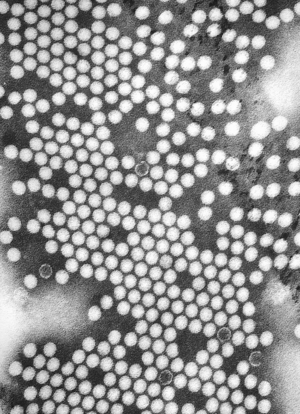
Poliomyelitis is caused by infection with a member of the genus Enterovirus known as poliovirus (PV). This group of RNA viruses colonize the gastrointestinal tract – specifically the oropharynx and the intestine. The incubation time (form the first signs and symptoms) ranges from three to 35 days, with a more common span of six to 20 days. PV infects and causes disease in humans alone. Its structure is quite simple, composed of a single (+) sense RNA genome enclosed in a protein shell called a capsid. In addition to protecting the virus' genetic material, the capsid proteins enable poliovirus to infect certain types of cells. Three serotypes of poliovirus have been identified – poliovirus type 1 (PV1), type 2 (PV2), and type 3 (PV3) – each with a slightly different capsid protein. All three are extremely virulent and produce the same disease symptoms. PV1 is the most commonly encountered form, and the one most closely associated with paralysis.
Individuals who are exposed to the virus, either through infection or by immunization via polio vaccine, develop immunity. In immune individuals, IgA antibodies against poliovirus are present in the tonsils and gastrointestinal tract and able to block virus replication; IgG and IgM antibodies against PV can prevent the spread of the virus to motor neurons of the central nervous system. Infection or vaccination with one serotype of poliovirus does not provide immunity against the other serotypes, and full immunity requires exposure to each serotype.
A rare condition with a similar presentation, nonpoliovirus poliomyelitis, may result from infections with nonpoliovirus enteroviruses.
Diagnosis
Paralytic poliomyelitis may be clinically suspected in individuals experiencing acute onset of flaccid paralysis in one or more limbs with decreased or absent tendon reflexes in the affected limbs that cannot be attributed to another apparent cause, and without sensory or cognitive loss.
A laboratory diagnosis is usually made based on the recovery of poliovirus from a stool sample or a swab of the pharynx. Antibodies to poliovirus can be diagnostic, and are generally detected in the blood of infected patients early in the course of infection. Analysis of the patient's cerebrospinal fluid (CSF), which is collected by a lumbar puncture ("spinal tap"), reveals an increased number of white blood cells (primarily lymphocytes) and a mildly elevated protein level. Detection of virus in the CSF is diagnostic of paralytic polio but rarely occurs.
If poliovirus is isolated from a patient experiencing acute flaccid paralysis, it is further tested through oligonucleotide mapping (genetic fingerprinting), or more recently by PCR amplification, to determine whether it is "wild type" (that is, the virus encountered in nature) or "vaccine type" (derived from a strain of poliovirus used to produce polio vaccine). It is important to determine the source of the virus because for each reported case of paralytic polio caused by wild poliovirus, an estimated 200 to 3,000 other contagious asymptomatic carriers exist.
Prevention
Passive immunization
In 1950, William Hammon at the University of Pittsburgh purified the gamma globulin component of the blood plasma of polio survivors. Hammon proposed the gamma globulin, which contained antibodies to poliovirus, could be used to halt poliovirus infection, prevent disease, and reduce the severity of disease in other patients who had contracted polio. The results of a large clinical trial were promising; the gamma globulin was shown to be about 80 percent effective in preventing the development of paralytic poliomyelitis. It was also shown to reduce the severity of the disease in patients who developed polio. Due to the limited supply of blood plasma gamma globulin was later deemed impractical for widespread use and the medical community focused on the development of a polio vaccine.
Vaccine
Two types of vaccine are used throughout the world to combat polio. Both types induce immunity to polio, efficiently blocking person-to-person transmission of wild poliovirus, thereby protecting both individual vaccine recipients and the wider community (so-called herd immunity).
The first candidate polio vaccine, based on one serotype of a live but attenuated (weakened) virus, was developed by the virologist Hilary Koprowski. Koprowski's prototype vaccine was given to an eight-year-old boy on 27 February 1950. Koprowski continued to work on the vaccine throughout the 1950s, leading to large-scale trials in the then Belgian Congo and the vaccination of seven million children in Poland against serotypes PV1 and PV3 between 1958 and 1960.
The second polio virus vaccine was developed in 1952 by Jonas Salk at the University of Pittsburgh, and announced to the world on 12 April 1955. The Salk vaccine, or inactivated poliovirus vaccine, is based on poliovirus grown in a type of monkey kidney tissue culture (vero cell line), which is chemically inactivated with formalin. After two doses of inactivated poliovirus vaccine (given by injection), 90 percent or more of individuals develop protective antibody to all three serotypes of poliovirus, and at least 99 percent are immune to poliovirus following three doses.
Subsequently, Albert Sabin developed another live, oral polio vaccine. It was produced by the repeated passage of the virus through nonhuman cells at subphysiological temperatures. The attenuated poliovirus in the Sabin vaccine replicates very efficiently in the gut, the primary site of wild poliovirus infection and replication, but the vaccine strain is unable to replicate efficiently within nervous system tissue. A single dose of Sabin's oral polio vaccine produces immunity to all three poliovirus serotypes in about 50 percent of recipients. Three doses of live-attenuated oral vaccine produce protective antibody to all three poliovirus types in more than 95 percent of recipients. Human trials of Sabin's vaccine began in 1957, and in 1958 it was selected, in competition with the live vaccines of Koprowski and other researchers, by the US National Institutes of Health. Licensed in 1962, it rapidly became the only polio vaccine used worldwide.
Because the oral polio vaccine is inexpensive, easy to administer, and produces excellent immunity in the intestine (which helps prevent infection with wild virus in areas where it is endemic), it has been the vaccine of choice for controlling poliomyelitis in many countries. On very rare occasions (about one case per 750,000 vaccine recipients), the attenuated virus in the oral polio vaccine reverts into a form that can paralyze. In 2017, cases caused by vaccine-derived poliovirus (cVDPV) outnumbered wild poliovirus cases for the first time, due to wild polio cases hitting record lows. Most industrialized countries have switched to inactivated polio vaccine, which cannot revert, either as the sole vaccine against poliomyelitis or in combination with oral polio vaccine.
Treatment
There is no cure for polio, but there are treatments. The focus of modern treatment has been on providing relief of symptoms, speeding recovery and preventing complications. Supportive measures include antibiotics to prevent infections in weakened muscles, analgesics for pain, moderate exercise and a nutritious diet. Treatment of polio often requires long-term rehabilitation, including occupational therapy, physical therapy, braces, corrective shoes and, in some cases, orthopedic surgery.
Portable ventilators may be required to support breathing. Historically, a noninvasive, negative-pressure ventilator, more commonly called an iron lung, was used to artificially maintain respiration during an acute polio infection until a person could breathe independently (generally about one to two weeks). Today, many polio survivors with permanent respiratory paralysis use modern jacket-type negative-pressure ventilators worn over the chest and abdomen.
Other historical treatments for polio include hydrotherapy, electrotherapy, massage and passive motion exercises, and surgical treatments, such as tendon lengthening and nerve grafting.
Sister Elizabeth Kenny's Kenny regimen is now the hallmark for the treatment of paralytic polio.
Prognosis
Patients with abortive polio infections recover completely. In those who develop only aseptic meningitis, the symptoms can be expected to persist for two to ten days, followed by complete recovery. In cases of spinal polio, if the affected nerve cells are completely destroyed, paralysis will be permanent; cells that are not destroyed, but lose function temporarily, may recover within four to six weeks after onset. Half the patients with spinal polio recover fully; one-quarter recover with mild disability, and the remaining quarter are left with severe disability. The degree of both acute paralysis and residual paralysis is likely to be proportional to the degree of viremia, and inversely proportional to the degree of immunity. Spinal polio is rarely fatal.
Without respiratory support, consequences of poliomyelitis with respiratory involvement include suffocation or pneumonia from aspiration of secretions. Overall, 5 to 10 percent of patients with paralytic polio die due to the paralysis of muscles used for breathing. The case fatality rate (CFR) varies by age: 2 to 5 percent of children and up to 15 to 30 percent of adults die. Bulbar polio often causes death if respiratory support is not provided; with support, its CFR ranges from 25 to 75 percent, depending on the age of the patient. When intermittent positive pressure ventilation is available, the fatalities can be reduced to 15 percent.
Recovery
Many cases of poliomyelitis result in only temporary paralysis. Generally in these cases, nerve impulses return to the paralyzed muscle within a month, and recovery is complete in six to eight months. The neurophysiological processes involved in recovery following acute paralytic poliomyelitis are quite effective; muscles are able to retain normal strength even if half the original motor neurons have been lost. Paralysis remaining after one year is likely to be permanent, although some recovery of muscle strength is possible up to 18 months after infection.
One mechanism involved in recovery is nerve terminal sprouting, in which remaining brainstem and spinal cord motor neurons develop new branches, or axonal sprouts. These sprouts can reinnervate orphaned muscle fibers that have been denervated by acute polio infection, restoring the fibers' capacity to contract and improving strength. Terminal sprouting may generate a few significantly enlarged motor neurons doing work previously performed by as many as four or five units: a single motor neuron that once controlled 200 muscle cells might control 800 to 1000 cells. Other mechanisms that occur during the rehabilitation phase, and contribute to muscle strength restoration, include myofiber hypertrophy – enlargement of muscle fibers through exercise and activity – and transformation of type II muscle fibers to type I muscle fibers.
In addition to these physiological processes, the body can compensate for residual paralysis in other ways. Weaker muscles can be used at a higher than usual intensity relative to the muscle's maximal capacity, little-used muscles can be developed, and ligaments can enable stability and mobility.
Complications
Residual complications of paralytic polio often occur following the initial recovery process. Muscle paresis and paralysis can sometimes result in skeletal deformities, tightening of the joints, and movement disability. Once the muscles in the limb become flaccid, they may interfere with the function of other muscles. A typical manifestation of this problem is equinus foot (similar to club foot). This deformity develops when the muscles that pull the toes downward are working, but those that pull it upward are not, and the foot naturally tends to drop toward the ground. If the problem is left untreated, the Achilles tendons at the back of the foot retract and the foot cannot take on a normal position. People with polio that develop equinus foot cannot walk properly because they cannot put their heels on the ground. A similar situation can develop if the arms become paralyzed.
In some cases the growth of an affected leg is slowed by polio, while the other leg continues to grow normally. The result is that one leg is shorter than the other and the person limps and leans to one side, in turn leading to deformities of the spine (such as scoliosis). Osteoporosis and increased likelihood of bone fractures may occur. An intervention to prevent or lessen length disparity can be to perform an epiphysiodesis on the distal femoral and proximal tibial/fibular condyles, so that limb's growth is artificially stunted, and by the time of epiphyseal (growth) plate closure, the legs are more equal in length. Alternatively, a person can be fitted with custom-made footwear which corrects the difference in leg lengths. Other surgery to re-balance muscular agonist/antagonist imbalances may also be helpful. Extended use of braces or wheelchairs may cause compression neuropathy, as well as a loss of proper function of the veins in the legs, due to pooling of blood in paralyzed lower limbs. Complications from prolonged immobility involving the lungs, kidneys and heart include pulmonary edema, aspiration pneumonia, urinary tract infections, kidney stones, paralytic ileus, myocarditis and cor pulmonale.
Post-polio syndrome
Between 25 percent and 50 percent of individuals who have recovered from paralytic polio in childhood can develop additional symptoms decades after recovering from the acute infection, notably new muscle weakness and extreme fatigue. This condition is known as post-polio syndrome (PPS) or post-polio sequelae. The symptoms of PPS are thought to involve a failure of the oversized motor units created during the recovery phase of the paralytic disease. Contributing factors that increase the risk of PPS include aging with loss of neuron units, the presence of a permanent residual impairment after recovery from the acute illness, and both overuse and disuse of neurons. PPS is a slow, progressive disease, and there is no specific treatment for it. Post-polio syndrome is not an infectious process, and persons experiencing the syndrome do not shed poliovirus.
Epidemiology
| Country | Wild cases |
Circulating vaccine- derived cases (cVDPV) |
Transmission status |
Type |
|---|---|---|---|---|
| 147 | 22 | endemic | WPV1 cVDPV2 |
|
| 29 | 0 | endemic | WPV1 | |
| 0 | 129 | cVDPV only | cVDPV2 | |
| 0 | 86 | cVDPV only | cVDPV2 | |
| 0 | 19 | cVDPV only | cVDPV2 | |
| 0 | 18 | cVDPV only | cVDPV2 | |
| 0 | 18 | cVDPV only | cVDPV2 | |
| 0 | 15 | cVDPV only | cVDPV1 cVDPV2 |
|
| 0 | 12 | cVDPV only | cVDPV2 | |
| 0 | 9 | cVDPV only | cVDPV2 | |
| 0 | 8 | cVDPV only | cVDPV2 | |
| 0 | 8 | cVDPV only | cVDPV2 | |
| 0 | 6 | cVDPV only | cVDPV1 | |
| 0 | 3 | cVDPV only | cVDPV2 | |
| 0 | 3 | cVDPV only | cVDPV1 | |
| 0 | 2 | cVDPV only | cVDPV2 | |
| 0 | 1 | cVDPV only | cVDPV2 | |
| 0 | 1 | cVDPV only | cVDPV2 | |
| 0 | 1 | cVDPV only | cVDPV2 | |
| 0 | 3 | cVDPV only | cVDPV1 | |
| Total | 175 | 365 | ||
Eradication
Following the widespread use of poliovirus vaccine in the mid-1950s, new cases of poliomyelitis declined dramatically in many industrialized countries. A global effort to eradicate polio - the Global Polio Eradication Initiative - began in 1988, led by the World Health Organization, UNICEF, and The Rotary Foundation. Polio is one of only two diseases currently the subject of a global eradication program, the other being Guinea worm disease. So far, the only diseases completely eradicated by humankind are smallpox, declared eradicated in 1980, and rinderpest, declared eradicated in 2011. In April 2012, the World Health Assembly declared that the failure to completely eradicate polio would be a programmatic emergency for global public health, and that it "must not happen."
These efforts have hugely reduced the number of cases; from an estimated 350,000 cases in 1988 to a low of 483 cases in 2001, after which it remained at a level of about 1,000–2000 cases per year for a number of years.
By 2015, polio was believed to remain naturally spreading in only two countries, Pakistan and Afghanistan, although it continued to cause outbreaks in other nearby countries due to hidden or reestablished transmission. Between 2016 and 2020 worldwide cases of wild polio (mostly in these countries) remained below 200 per year, with only 6 confirmed cases in 2021.
A concern is the presence of circulating vaccine-derived polioviruses (cVDPV). The oral polio vaccine is not perfect: while the genetic characteristics are carefully balanced to maximize efficacy and minimize virulence, the poliovirus in the oral vaccine can mutate. As a result, persons given the oral polio vaccine can acquire acute or chronic infections; or can transmit (circulate) mutated virus to other people. Cases of cVDPV now exceed wild-type cases, making it desirable to discontinue the use of the oral polio vaccine as soon as safely possible and instead use other types of polio vaccines.
Images for kids
-
A blockage of the lumbar anterior spinal cord artery due to polio (PV3)
-
Denervation of skeletal muscle tissue secondary to poliovirus infection can lead to paralysis.
See also
 In Spanish: Poliomielitis para niños
In Spanish: Poliomielitis para niños


